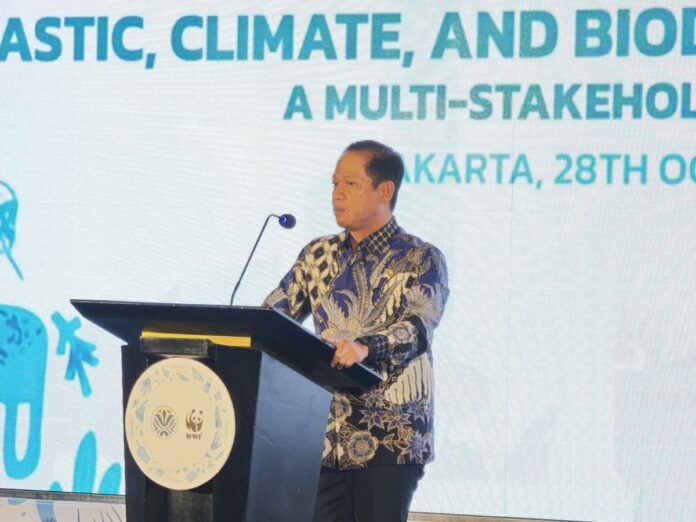Ecobiz.asia — Indonesia has officially submitted its Second Nationally Determined Contribution (Second NDC) to the UNFCCC, setting more ambitious greenhouse gas (GHG) reduction targets than the previous Enhanced NDC.
Minister of Environment Hanif Faisol Nurofiq said Indonesia’s new climate document introduces an emission target below the 2019 emission level, which now serves as the base year. Under the new approach, Indonesia aims to peak its GHG emissions at 1.3 gigatons CO₂e under the low-emission scenario (LCCP-L) and 1.4 gigatons CO₂e under the high-emission scenario (LCCP-H) by 2030.
“Compared to the Enhanced NDC, the Second NDC is more ambitious. The figures we submitted to the UNFCCC are higher than those in the previous document,” Hanif said during the Multi-Stakeholder Dialogue: Plastic, Climate and Biodiversity Nexus Forum in Jakarta, Tuesday (Oct. 28, 2025).
The previous Enhanced NDC projected Indonesia’s peak emissions at 1.9 gigatons CO₂e with domestic efforts (Countermeasure 1) and 1.6 gigatons CO₂e with international support (Countermeasure 2). Based on the new Low Carbon Compatible with the Paris Agreement (LCCP) framework, Indonesia’s target represents an 8–17.5% reduction from the 2030 projections under the Enhanced NDC.
Under the LCCP scenarios, Indonesia is expected to reach peak emissions in 2030 with estimated levels of 1,345,707 Gg CO₂e under LCCP-L and 1,491,474 Gg CO₂e under LCCP-H, before gradually declining by 2035 to 1,257,717 Gg CO₂e (LCCP-L) and 1,488,866 Gg CO₂e (LCCP-H).
The emission reduction focus covers five key sectors: energy, waste, agriculture, industrial processes and product use (IPPU), and forestry and other land use (FOLU). The FOLU sector remains the backbone of mitigation, targeting FOLU Net Sink 2030, the restoration of 2 million hectares of peatland, and rehabilitation of 8.3 million hectares of degraded land.
In the energy sector, the government aims for a 19–23% share of renewables by 2030 and 70% by 2060. Implementation is supported by several key regulations, including Government Regulation No. 33/2023 on energy conservation, Presidential Regulation No. 112/2022 on renewable energy acceleration, and Presidential Regulation No. 110/2025 on carbon pricing instruments.
The Second NDC also highlights the integration of mitigation and adaptation efforts through programs such as the Climate Village Program (ProKlim), the strengthening of the National Registry System (SRN) connected to the Indonesia Stock Exchange for carbon trading, and the application of just transition principles to ensure an inclusive and equitable energy transition.
The government estimates a total investment requirement of USD 472.6 billion through 2035 to implement the Second NDC, partly funded through the national budget and managed by the Environmental Fund Management Agency (BPDLH). ***






